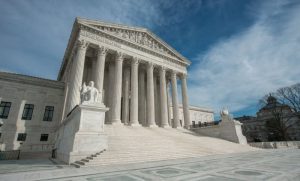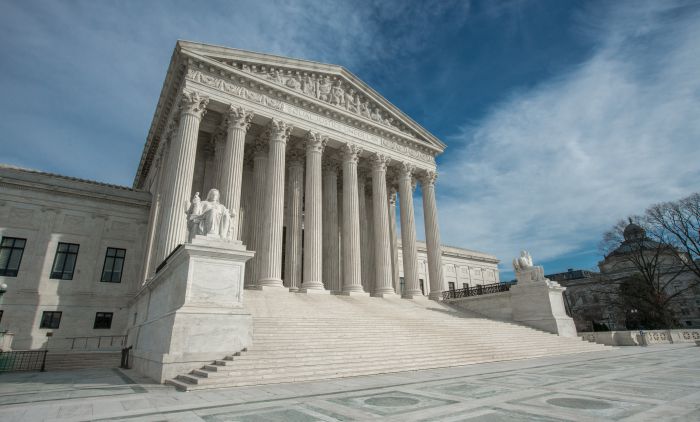SCOTUS Forum. In the first of a roundtable of op-eds on the Supreme Court’s Amex decision of June 25, Chris Sagers harks back to William Howard Taft’s warning that entertaining defenses of patently anticompetitive behavior would be to “set sail on a sea of doubt.” The Amex decision, writes Sagers, shows Taft was right.
 Justice Clarence Thomas does not write many antitrust opinions. When he does they tend to be kind of doozies, and not in a good way.
Justice Clarence Thomas does not write many antitrust opinions. When he does they tend to be kind of doozies, and not in a good way.
The last big one that comes to mind was a 2006 decision called Texaco, Inc. v. Dagher, which strongly implied that a gasoline marketing joint venture was a “single entity” not even subject to Sherman Act § 1. That was so even though it was mainly just a price-fixing agreement covering a quarter of its market, between two firms that otherwise remained quite separate, and though the record showed that it caused price increases with no offsetting benefit. No one much disagrees that the opinion turned on a potentially very serious misunderstanding of the so-called ancillary restraints rule, which the Court effectively reversed sub silentio just a few years later in American Needle, Inc. v. NFL. And then there was United States v. Baker Hughes, a merger opinion by then Judge Thomas for the DC Circuit. It approved a merger on breathtaking concentration numbers, largely on the mere conjectural possibility of entry, because he thought it “onerous” were defendants required actually to prove likely entry. That opinion and a few others by conservative lower-court judges rewrote merger law during the 1980s and 1990s, with input from neither Congress nor the Supreme Court. They are largely responsible for merger law’s death, and are the central cause of calamities like the government’s recent loss in United States v. AT&T. Overall, the impression is of a Justice without much depth in this particular law, who could not care less about its effectiveness, and above all, who cannot fathom an antitrust defendant ever losing.
Well, Monday’s opinion in Ohio v. American Express was like that.((Full disclosure: I signed an amicus brief in the case, with a few dozen other law professors, supporting the government. We don’t do that kind of thing for money, to be clear, and have no pecuniary or other stake in the case at all. It’s just in the interest of making the law better.)) The Court’s five conservatives held in an opinion by Justice Thomas that the “anti-steering” rules that Amex imposes on merchants are legal. Under those rules, merchants cannot tell customers how much American Express charges them, or encourage the use of less costly cards. The case came to the Court on the Second Circuit’s rare rejection of fact-findings following full trial. It rejected them in kind of a crazy opinion by a judge who had claimed in open court that credit card markets must be really, really competitive because he gets lots of credit card offers in the mail.
Justice Thomas’s opinion was pretty much the same. There is again a more or less outright rejection of the trial court’s fact-finding—something that is supposed to happen in only the rarest circumstances—supported only by the Court’s wholesale adoption of a speculative theoretical literature on “two-sided markets.” Justice Thomas threw in some fairly loony navel-gazing, like a Trinko-esque argument (slip op. at 19-20) that price competition itself would be the problem, because it would deny Amex holders the warm fuzzy of “welcome acceptance,” or the several bizarre suggestions that anti-steering rules are a boon to the poor. (A meaningfully substantiated consequence of the credit-card oligopoly is systematic harm to the poor, since cash purchasers bear more of the cost of cash-back rewards and other benefits enjoyed by premium cardholders.)
| William Howard Taft first explained that self-evidently anticompetitive conduct should just be illegal, without indulgence of whatever speculative justifications the defendants might dream up. Indulging them, he said, would be to “set sail on a sea of doubt.” |
On the Court’s own numbers, credit cards are hugely concentrated. (For aficionados, it’s a three-firm oligopoly with an HHI in excess of 3200, and since credit cards remain dominant, the numbers would be similar even among more broadly defined “payment systems.”) The three big players—Visa, Mastercard, and Amex—hold about 94 percent of the market, and Amex alone holds more than one-quarter of it. Whether you believe the Court’s claims depends on whether you think the number-two firm in a three-firm oligopoly simply can’t have market power because—like all kinds of other firms, as it turns out—it must worry about more than one constituency at a time. It’s not a wild guess that in fact the industry structure and practices like anti-steering explain why credit card swipe fees are higher in America than anywhere else. In Europe, where government has not yet gone entirely mad, the two-sided market theory has been accepted, but not as a reason to exempt oligopolists from the law entirely. Swipe fees are lower—and note that credit card firms nonetheless manage somehow to survive—because government there subjects them to price controls.
The problem with two-sided market theory is not that I know it’s wrong, though I think it probably is. It’s that the use in antitrust law of theories like this invites problems that courts handle very poorly, and it makes the law much too hard to enforce. America’s first great antitrust scholar, William Howard Taft, first explained that self-evidently anticompetitive conduct should just be illegal, without indulgence of whatever speculative justifications the defendants might dream up. Indulging them, he said, would be to “set sail on a sea of doubt.” It would involve impossible epistemological and practical challenges and would render the law inert. Amex is pretty much like what he said we shouldn’t do. The mere untested possibility that there could be net gain from anti-steering now means that plaintiffs in any credit card case would have to prove two relevant markets, and quantify effects in both of them to the fact-finder’s satisfaction, while defendants can counter with further conjectures that are effectively impossible to disprove. (Note that I said plaintiffs “would” have to do that, hypothetically, because absent smoking-gun evidence of naked price conspiracy, no plaintiff will ever bring another challenge in this industry.)
A larger problem is where all this might stop. Strictly speaking, the theory purports to apply only when narrowly specified circumstances are present, and Amex further limits it to “transaction platforms” in which “indirect network effects” are strong (slip op. at 12-13 & n.9). But we can expect every antitrust defendant and their sister to start claiming that their business is two-sided, and lower courts will find reason within the theory to give their claims the time of day. After all, even a brick-and-mortar retail store is “two-sided” in the sense that it must balance the demands of suppliers and customers. It may plausibly be to everyone’s benefit if store owners use collusion or coercion to give benefits to one side at the expense of the other. Or whatever. (Honestly, I’m not sure why Amex doesn’t imply that every antitrust case should just be an exercise in general equilibrium theory.) And yes, I know, the brilliant women and men currently selling this theory can explain why it will not have those consequences. But they sadly are not the judges who will decide the cases, and they seem unaware or unconcerned with the motive and opportunity that courts and litigants will have to abuse their work.
| One can hope for the best in these kinds of cases, and the best from my point of view would be that Ohio v. Amex is restricted as narrowly to its own facts as Dagher was. But there could be pretty substantially worse outcomes, the worst being that Amex will be to two-sided market theory what Continental TV v. GTE Sylvania was to free-riding. |
C’est la vie. Generating theories to explain why particular defendants can’t be expected to compete has been an industry among economists for as long as there has been antitrust. The law was first derided by economists on turn-of-the-century ruinous competition arguments, before they decided that those arguments don’t actually explain the world, and most periods since have generated some similar effort. The mere speculative possibility of “free-riding” has made resale price maintenance all but per se legal, though some of RPM’s chief defenders now admit that it may frequently explain the world quite poorly. Meanwhile, some tentative support is emerging for the unsurprising view that it has mainly just caused price increases with no benefit at all. A closer parallel yet to Amex was the largely hook-line-and-sinker embrace of the 1970s-era “uprising” in “contestability” theory. That was another innovation so brilliant that it wagged the dog of antitrust enforcement almost completely for a decade or so, resulting in the rapid consolidation of the airlines and other sectors and many decisions like Baker Hughes, but it then proved inaccurate enough that its own progenitors admitted it.
Anyway, one can hope for the best in these kinds of cases, and the best from my point of view would be that Ohio v. Amex is restricted as narrowly to its own facts as Dagher was. But there could be pretty substantially worse outcomes, the worst being that Amex will be to two-sided market theory what Continental TV v. GTE Sylvania was to free-riding.
Ronald Coase once famously mocked the “preoccupation” of mid-century economists “with the monopoly problem.” When such “an economist finds something . . . that he does not understand,” said Coase, “he looks for a monopoly explanation.” That shoe has emphatically switched feet. Economists refuse to accept even the most obviously persuasive monopoly explanations until we disprove whatever theoretical conjectures they can dream up. If that sort of thing was absurd in Coase’s time, it is now too.
Disclaimer: The ProMarket blog is dedicated to discussing how competition tends to be subverted by special interests. The posts represent the opinions of their writers, not necessarily those of the University of Chicago, the Booth School of Business, or its faculty. For more information, please visit ProMarket Blog Policy.






